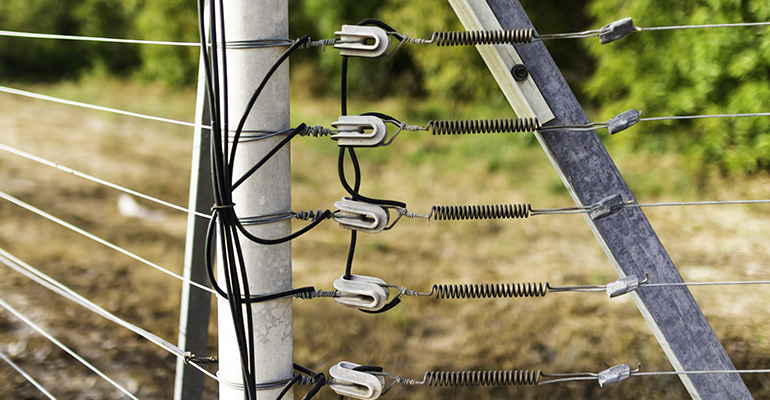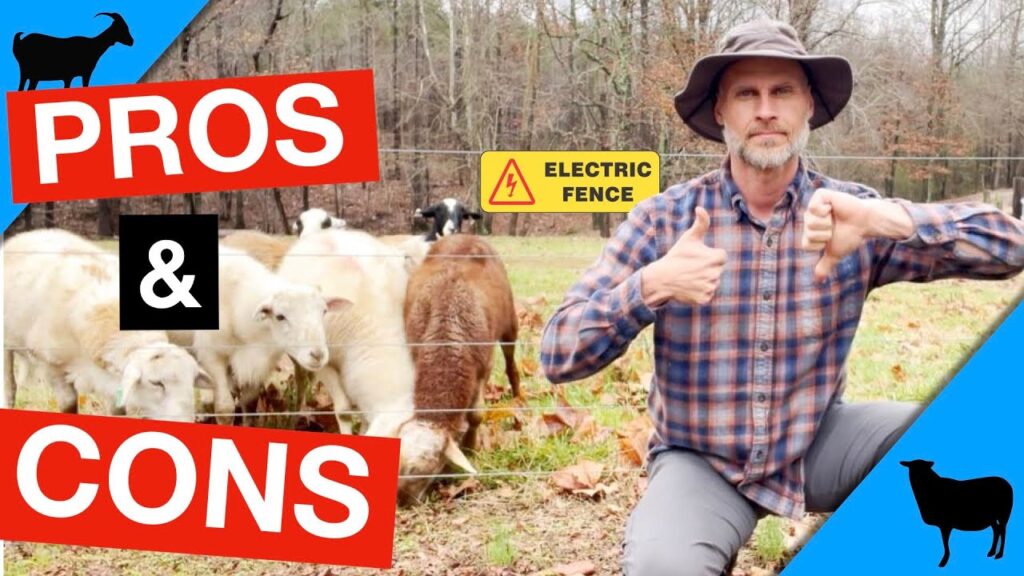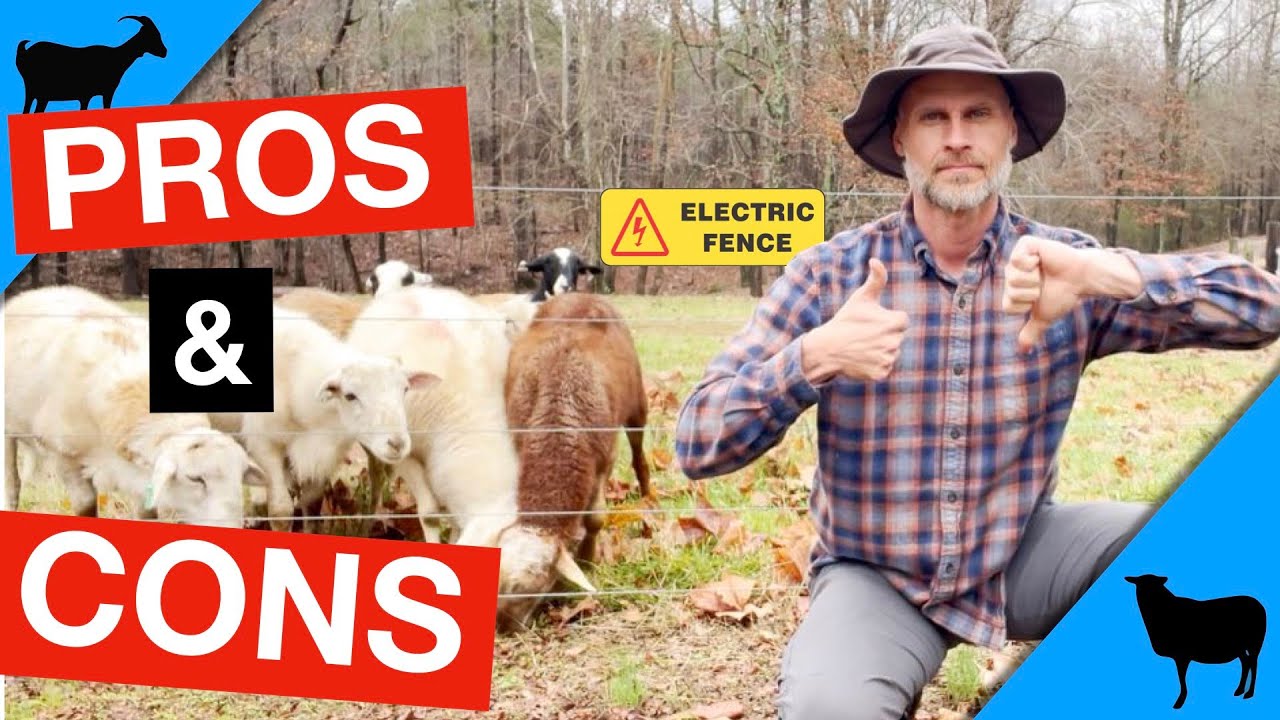Have you ever considered using electric fencing for your property? It can be an effective way to keep unwanted animals out and protect your belongings. But before you make a decision, it’s important to weigh the pros and cons of electric fencing.
In my upcoming article, I’ll dive into the world of electric fencing and discuss all the ins and outs of this popular fencing option. We’ll explore the benefits, such as its affordability and ease of installation, as well as the drawbacks, such as potential harm to animals and maintenance requirements. Whether you’re a homeowner looking to secure your backyard or a farmer needing to keep livestock safe, this article will provide you with the information you need to make an informed decision. Stay tuned to learn more about the pros and cons of electric fencing!
With our friendly and conversational tone, you’ll feel like we’re talking directly to you as we delve into the topic of electric fencing. We’ll cover everything from how it works to the different types of electric fencing available on the market. Additionally, we’ll touch on important considerations like safety measures and regulations you need to be aware of. By the end of the article, you’ll have a clear understanding of whether electric fencing is the right choice for your needs. So, are you ready to learn more? Let’s get started!
The Pros and Cons of Electric Fencing
Electric fencing has become a popular choice for many property owners seeking effective security solutions. With its ability to deter potential intruders and contain livestock, electric fencing offers a range of benefits. However, like any other fencing system, it also has its drawbacks. In this article, we will explore the pros and cons of electric fencing, discuss various types of electric fences, consider how to choose the right electric fence charger, provide installation tips, highlight maintenance and troubleshooting practices, address safety concerns, compare it to traditional fencing options, debunk common myths, explore its applications, examine environmental considerations, delve into social issues, and share some success stories. So, let’s get started and take a closer look at electric fencing!

Pros of Electric Fencing
Increased Security
One of the most significant advantages of electric fencing is the enhanced security it provides. The electric shock delivered by the fence acts as a strong deterrent, discouraging potential intruders from attempting to breach the perimeter. Whether it’s protecting your property from trespassers or keeping predators away from livestock, electric fencing can significantly increase the level of security.
Cost-Effective
Electric fencing offers a cost-effective solution compared to traditional fencing options. The initial cost of installing an electric fence may be higher, but its long-term benefits outweigh the expense. Electric fencing requires less maintenance and repair, saving you money in the long run. Moreover, the ability to quickly and easily modify the layout of the fence adds to its cost-effectiveness.
Versatility and Flexibility
Electric fencing provides a high level of versatility and flexibility. It can be customized to suit various needs, whether you are containing livestock, protecting a garden, or securing a specific area. The ability to adjust the voltage and choose different wire types allows you to tailor the fence to your specific requirements.
Easy Installation
Installing an electric fence is relatively straightforward, making it a popular choice for property owners. With the availability of easy-to-follow installation guides and the right tools, you can set up an electric fence in a short amount of time. The simplicity of the installation process saves you both time and effort, ensuring a hassle-free experience.
Cons of Electric Fencing
Potential Harm to Animals
Although electric fencing is an effective way to contain livestock, it can potentially harm animals if not used correctly. The electric shock from the fence can cause stress and injury to animals if the voltage is too high or the duration of the shock is excessive. Proper training and monitoring of animals are essential to mitigate these risks effectively.
Aesthetically Unappealing
Some individuals may find electric fences visually unappealing. The presence of wires and the need for additional support structures can disrupt the aesthetics of a property. However, with advancements in electric fence design, there are options available that are more visually appealing and less obtrusive.
Maintenance and Repairs
While electric fencing requires less maintenance compared to traditional fencing, it still requires regular upkeep. Routine inspections, cleaning of wire connections, and replacing damaged components are necessary to keep the fence functioning optimally. Additionally, occasional repairs may be required due to factors such as wildlife damage or extreme weather conditions.
Potential Legal Issues
Before installing an electric fence, it is important to be aware of any local regulations and zoning laws that may restrict or regulate its use. Failure to comply with these regulations can result in legal issues and penalties. It is essential to research and understand the applicable rules and regulations before installing an electric fence on your property.

Types of Electric Fencing
Electric fencing comes in various forms, each designed to serve specific purposes. Let’s explore some of the common types of electric fencing:
High-Tensile Electric Fencing
High-tensile electric fencing utilizes high-strength wires under high tension to create a strong and secure perimeter. This type of fencing is commonly used for containing livestock, particularly larger animals. It offers durability, strength, and an effective deterrent against intruders.
Polytape Electric Fencing
Polytape electric fencing consists of a combination of woven tape and conductive wires. The wider tape provides better visibility and is particularly effective in containing horses and other animals that are more sensitive to electric shocks. Polytape fencing is lightweight, easy to install, and offers good conductivity.
Polywire Electric Fencing
Polywire electric fencing is similar to polytape, but it is made of lightweight woven wire instead of tape. Its thinner profile makes it less visible, making it suitable for locations where aesthetics are a concern. Polywire is highly versatile and can be used for various animal types, including those with thick coats.
Electro-Rope Electric Fencing
Electro-rope electric fencing combines the benefits of traditional rope fencing with the added security of electric shocks. It consists of multiple strands of conductive rope, offering excellent conductivity and visibility. Electro-rope fencing is particularly effective in containing livestock and deterring predators.
Choosing the Right Electric Fence Charger
The electric fence charger, also known as an energizer or fencer, is a crucial component of the electric fencing system. Here are some factors to consider when selecting the right electric fence charger for your specific needs:
Consider Your Livestock and Voltage Needs
Different animals have different tolerance levels for electric shocks. Consider the type and size of the animals you want to contain, as well as their reaction to electric shocks. Select an electric fence charger with the appropriate voltage to ensure effective containment without causing harm to the animals.
Evaluate Power Options
Electric fence chargers can be powered by various sources, including mains power, batteries, or solar power. Consider the availability of power sources in your location and choose the one that is most practical and convenient for your needs. Solar-powered chargers offer the added benefit of being environmentally friendly and cost-effective in the long run.
Brands and Reviews
Research and consider different brands of electric fence chargers to find one that is reliable, durable, and well-regarded by users. Read reviews and experiences of others to gain insight into the performance and longevity of different charger models.
Warranty and Customer Support
Choose an electric fence charger that comes with a warranty and good customer support. Having access to technical assistance and the ability to replace or repair faulty chargers can save you from potential hassles and additional expenses in the future.

Installing an Electric Fence
Installing an electric fence requires proper planning and preparation. Consider the following steps to ensure a successful installation:
Check Local Regulations and Zoning Laws
Before beginning the installation process, research and understand any local regulations and zoning laws that may apply to electric fencing. Compliance with these regulations is crucial to avoid legal issues and potential penalties.
Gather Necessary Tools and Materials
Ensure you have all the necessary tools and materials before starting the installation. These may include fence posts, insulators, wire, connectors, grounding rods, and an electric fence charger. Having everything on hand will streamline the installation process and prevent unnecessary delays.
Plan the Layout and Posts
Determine the perimeter of the area you want to enclose and plan the layout of the fence accordingly. Consider the terrain, soil conditions, and any obstacles that may require special attention. Mark the locations for fence posts, ensuring they are evenly spaced and sturdy enough to withstand tension.
Properly Ground the System
Grounding is a critical step in electric fence installation. It ensures that the electric circuit is completed when an animal comes into contact with the fence. Follow the manufacturer’s guidelines for proper grounding, including the use of grounding rods and ensuring a good connection between the charger and the ground system.
Maintenance and Troubleshooting
Regular maintenance and troubleshooting are essential to keep your electric fence in optimal condition. Here are some practices to follow:
Regular Inspection and Repair
Periodically inspect the fence for any damage, loose wires, or faulty components. Repair or replace damaged parts promptly to maintain the fence’s effectiveness and prevent potential issues.
Monitoring Performance and Voltage
Regularly check the voltage of your electric fence to ensure it is operating within the desired range. Monitoring the fence’s performance and voltage will help identify any potential problems before they escalate.
Identifying and Fixing Short Circuits
Short circuits can occur due to vegetation touching the electric wire or damage to insulators. It is crucial to identify and fix short circuits promptly to ensure the proper functioning of the fence.
Winterizing the System
Cold weather conditions can affect the performance of the electric fence. Take appropriate measures to winterize the system, such as clearing snow and keeping the fence free from ice buildup. Ensure that the charger and other components are protected from extreme cold.

Electric Fence Safety
Safety is of utmost importance when it comes to using electric fencing. Here are some safety guidelines to follow:
Warning Signs and Labels
Place warning signs and labels at regular intervals along the electric fence to inform people of its presence and the potential for electric shocks. These signs can help prevent accidental contact and minimize the risk of injury.
Proper Signage and Notifications
If you are using electric fencing in a public area or near a public footpath, it is essential to provide proper signage and notifications. Informing the public about the presence of an electric fence will help reduce the risk of accidental contact and potential legal issues.
Educating Children and Visitors
Teach children and visitors about the potential dangers of electric fencing and the importance of maintaining a safe distance. Providing appropriate education and supervision will ensure their safety and prevent any accidents.
Protective Gear and Precautions
When working around or with an electric fence, it is advisable to wear protective gear such as insulated gloves and footwear. Taking precautions will reduce the risk of electric shocks and injuries.
Comparing Electric Fencing to Traditional Fencing
Electric fencing and traditional fencing options each have their own advantages and disadvantages. Let’s compare them in various aspects:
Cost Comparison
Electric fencing is generally more cost-effective in the long run. While the initial installation may be more expensive, the reduced maintenance and repair costs make it a more economical choice over time. Traditional fencing options may require frequent repairs and replacements, increasing long-term expenses.
Effectiveness and Security
Electric fencing offers enhanced security due to the deterrent effect of the electric shock. Traditional fencing relies mainly on physical barriers, which can be easier to breach or damage. Electric fencing provides a higher level of security and reliable containment.
Maintenance Requirements
Maintaining electric fencing is generally less time-consuming and costly compared to traditional fencing. Traditional fences often require frequent painting, repairs, and replacement of boards or wire. Electric fencing requires regular inspections and occasional repairs, but overall, its maintenance requirements are minimal.
Installation Time
Installing electric fencing is typically quicker and easier compared to traditional fencing, especially when using simple wire systems. Traditional fences may require more time and effort, particularly for more complex designs or when dealing with challenging terrain.

Common Myths about Electric Fencing
Various myths surround electric fencing. Let’s debunk some of the most common ones:
Electric Fencing Harms Animals
When used correctly and at appropriate voltage levels, electric fencing does not cause harm to animals. The electric shock delivered by the fence is designed to act as a deterrent and train animals to avoid contact. Proper training and monitoring ensure the safety and well-being of the animals.
Electric Fencing Causes Fires
Electric fencing is not a fire hazard as long as it is installed and maintained properly. The low voltage used in electric fences is not enough to spark a fire, even in dry conditions. However, it is essential to keep the fence clear of dry vegetation and follow proper installation guidelines to minimize any fire risks.
Animals Easily Escape Electric Fencing
With proper training and containment techniques, animals are unlikely to escape from electric fencing. The electric shock acts as a psychological barrier for animals and trains them to respect the fence’s boundaries. Regular monitoring and maintenance will ensure the fence’s effectiveness in containing animals.
Electric Fencing is Expensive
While the initial cost of electric fencing may be higher than some traditional fencing options, its long-term benefits outweigh the expense. The reduced maintenance and repair costs of electric fencing make it a more cost-effective choice in the long run.
Applications of Electric Fencing
Electric fencing finds applications in various fields. Let’s explore some common uses:
Livestock and Animal Containment
Electric fencing is widely used for containing livestock, such as cattle, horses, and goats. It provides a reliable and effective way to keep animals within designated areas and protect them from external threats.
Garden and Crop Protection
Electric fencing is an excellent choice for protecting gardens and crops from wildlife damage. It acts as an effective deterrent, preventing animals from accessing and damaging valuable vegetation.
Wildlife Management
Electric fencing plays a crucial role in wildlife management, particularly in areas where human-wildlife conflict is prevalent. It helps keep animals away from human settlements and agricultural fields, reducing the potential for conflicts and damage.
Perimeter Security
Electric fencing provides a high level of perimeter security for residential, commercial, and industrial properties. It acts as a strong deterrent and prevents unauthorized access, enhancing overall security.
Environmental Considerations
When considering electric fencing, it’s essential to take into account the environmental impact. Let’s explore some key considerations:
Impact on Wildlife and Habitat
Electric fencing may have an impact on wildlife and their habitats. It is important to carefully consider the location and design of the fence to minimize any adverse effects on local fauna and flora. Incorporating wildlife-friendly features, such as wildlife gates or escape routes, can help mitigate potential negative impacts.
Energy Efficiency
Electric fence chargers have become more energy-efficient over time, reducing their impact on energy consumption. Choosing energy-efficient models and opting for alternative power sources, such as solar-powered chargers, can further enhance the environmental friendliness of the system.
Alternative Power Sources for Electric Fencing
In addition to traditional power sources like mains and batteries, alternative power sources like solar and wind can be utilized to power electric fences. These renewable energy options reduce reliance on non-renewable resources and minimize the overall environmental footprint.
Erosion and Soil Impact
Certain electric fence designs may impact soil health or contribute to erosion, particularly when improperly installed or in sensitive areas. Careful consideration of these factors and the use of erosion control measures can help minimize any negative effects.
Public Perception and Social Issues
Electric fencing can raise concerns and social issues that need to be addressed. Let’s explore a few key areas:
Ethical Concerns about Animal Containment
Some individuals may have ethical concerns related to the use of electric fencing for containing animals. Proper education, adherence to best practices, and transparency in management practices can help address these concerns and foster an understanding of the benefits electric fencing provides in ensuring animal safety and containment.
Community Acceptance and Regulations
Community acceptance plays a vital role in the successful implementation of electric fencing projects. Engaging with the local community, addressing their concerns, and ensuring compliance with regulations can contribute to positive reception and support.
Public Education and Awareness
Raising public awareness about the benefits, proper use, and safety measures associated with electric fencing is crucial. Educating the public about its effectiveness, animal welfare considerations, and proper installation methods can help address misconceptions and foster a better understanding of electric fencing.
Alternatives to Electric Fencing
In certain situations, alternatives to electric fencing may be more suitable or preferred. Exploring and promoting alternative methods, such as non-lethal animal deterrents or physical barriers, can provide options for individuals or communities with concerns about electric fencing.
Success Stories and Case Studies
Let’s explore a few success stories and case studies showcasing the positive impact of electric fencing:
Farmers’ Experiences with Electric Fencing
Numerous farmers have reported positive experiences with electric fencing. They have observed increased livestock containment, reduced predation risks, and improved overall farm security. Electric fencing has allowed them to efficiently manage their land and protect their livelihoods.
Successful Wildlife Conservation Projects
Electric fencing has been instrumental in the success of wildlife conservation projects worldwide. From protecting endangered species’ habitats to reducing human-wildlife conflicts, electric fences have proven to be effective tools for promoting coexistence between humans and wildlife.
Security Improvements with Electric Fencing
Numerous properties, ranging from private residences to commercial establishments, have reported significant security improvements with the installation of electric fencing. The strong deterrent effect has deterred potential intruders and reduced instances of trespassing and crime.
Gardeners’ Stories of Crop Protection
Gardeners and farmers have shared success stories about protecting their crops from wildlife using electric fencing. By effectively deterring animals like deer, rabbits, and squirrels, electric fences have helped maintain thriving gardens and increased crop yields.
Conclusion
Electric fencing offers a range of benefits, including increased security, cost-effectiveness, versatility, and ease of installation. However, it also has its drawbacks, such as potential harm to animals and aesthetic concerns. By understanding the pros and cons, choosing the right electric fence charger, following proper installation and maintenance practices, addressing safety concerns, and considering environmental and social aspects, electric fencing can be an effective and practical choice. Now that you have a deeper understanding of electric fencing, you can make an informed decision about whether it is the right choice for your specific needs. Remember to consult with experts, adhere to local regulations, and prioritize the safety and well-being of both humans and animals. With careful planning and implementation, electric fencing can provide a reliable and efficient solution for various applications.
